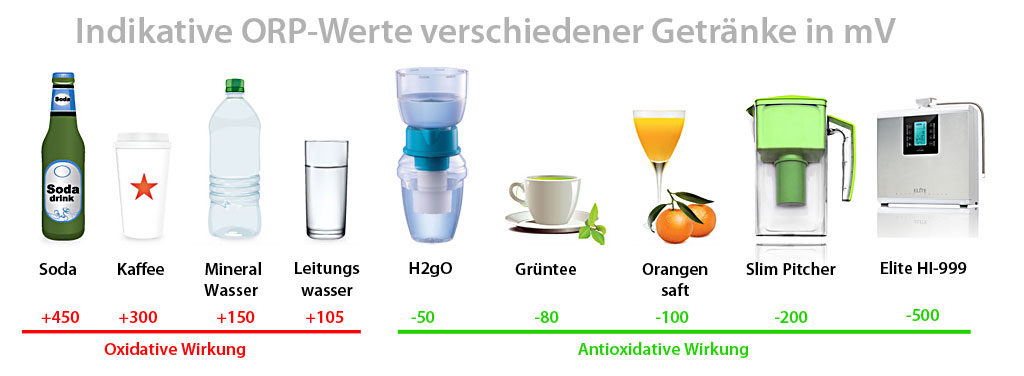Difference of active water
How is ionized water different from ordinary tap water?
1. The pH value of ionized water (active water, Kangen water) is alkaline and can be individually adjusted.

Our blood has a pH of 7.45. It is slightly alkaline. If the pH of the blood would drop to 7.3, the blood could only transport 60% of the normal oxygen value. Therefore, the body does everything to maintain the blood pH in the range of 7.45. This can be achieved, for example, by the decomposition of calcium from the bone mass. On radiographs only visible if more than 40% of the bone mass was broken down!
Water ionizers can make alkaline water up to a pH of 12. Therapists, such as Dr. med. Walter Irlacher, use active water to balance the acidic-base balance as quickly as possible. He uses water with a pH value of 10. We recommend the use of water with a pH of 7.5 to 8.5.
2. The ORP value – measured in millivolt

The oxidation reduction potential (ORP) is the anti-oxidative effect of a substance. Free oxygen atoms (O), also known as free radicals, can be very aggressive in our body. They can for example destroy cell walls. Alkaline water can bind free radicals in the body. Since we should drink a lot of water anyway, the drinking of active water is a very appropriate means to promote well-being without altering your favorite habits. In Japan, water ionizers are regarded as medical devices and certified by the Health Office. The main reason for this is the antioxidative effect of ionized water.
Another great advantage of alkaline water is that it tastes pleasantly soft. This promotes the desire to drink this water. Many elderly people, who have literally forgotten how to drink water, drink more.
3. Cluster size of the water molecules is smaller than in the case of ordinary tap water

The chemical structure of water makes it polar. That means it has a side with an increased positive charge and one with a rather negative charge. As a result, the water molecules (H2O) are joined by hydrogen bonds. Mountain water has a cluster size of 5 to 6 water molecules per hydrogen bond. Ordinary tap water has between 12 to 18 water molecules per cluster. This is partly due to the long distances and high pressures in the water pipes. It is important in this context because the smaller hydrogen assemblies can be more easily absorbed by the human cells. Thus the water can fulfill its transport functions better. Among other things, the transport of nutrients into the cells and the degradation of waste products, which are mostly acidic, out of the cells works better. Thus, ionized water hydrogenates better and can transport acidic waste better our of the cells.



